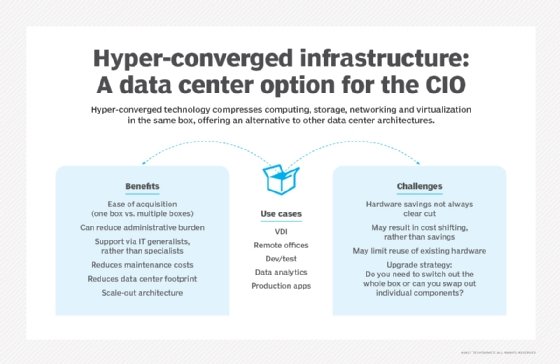
WavebreakmediaMicro - Fotolia
When traditional data center technology trumps hyper-converged
Committing to a conventional data center rather than a hyper-converged approach is sometimes the smarter move. We take a look at some reasons to steer clear of HCI.
Hyper-converged infrastructure data centers have generated a great deal of interest over the past few years for some good reasons. They have the potential to lower costs, while providing more automation, enhanced data protection, simplified technology procurement and support. And HCI often enables a smaller, more efficient IT staff.
Yet, despite all these compelling benefits, there are times when it makes sense to forego HCI technology and embrace three-tier traditional data center technology.
HCI vs. a traditional data center
HCI is designed to seamlessly integrate compute, networking and storage functions into a single unified box. All of these technologies function individually even though they're housed in the same physical unit. This "data center in a box" concept enables key resources to be efficiently pooled and shared. Depending on how it's constructed, an HCI system can also incorporate a variety of other useful components, such as capacity optimization, data compression, auto-tiering and WAN optimization. The entire HCI is managed via software.
An HCI often forms the foundation of a complete SDDC. The main distinction is the addition of an orchestration layer that includes policy-driven automation and management. The orchestration layer allows for more proactive monitoring, automated policy management and automated provisioning, as well as more effective capacity planning. Even then, many enterprises may still have good reason to go with a conventional data center.

"Depending upon the type of management systems used within the SDDC scenario, there may be many benefits to deploying within a more traditional data center framework," said Jack Pouchet, vice president of business development at Vertiv, a data center equipment and services provider.
Among the benefits of sticking with a conventional data center that Pouchet identified are:
- Not all IT assets are plug-and-play compatible with SDDC management systems.
- Many organizations continue to use legacy systems, especially storage devices, where the cost and security involved with migration may outweigh any perceived benefits.
- It's easier to mix and match hardware suppliers on the fly with a traditional data center.
- SDDC introduces another threat vector -- perhaps several, depending upon the implementation -- for cyberattacks.
- A move to HCI involves manpower costs associated with the implementation process and investment in new hardware and software that could instead be put toward additional storage or switching and rounding hardware.
- Hyper-converged infrastructure can also include costs related to operational management systems, protocols and audits.
Overcoming obstacles
Factors that discourage many enterprises from using a traditional data center, such as power and cooling cost concerns, are rapidly falling by the wayside.
"We're seeing, on a global basis, an increase in the amount of data center floor space and/or rack space being allocated to storage applications," Pouchet said. "When planned for from the outset, this can lend itself to optimal cooling zones within the data center with thermal load balancing to match the lower kilowatt loadings typically found in storage with higher density thermal zones for IT workloads."
Pouchet also noted that data sovereignty and privacy regulations are creating a need for local or regional data storage that's being met with purpose-built facilities that are almost completely dedicated to storage with minimal compute, record search and networking for administrative purposes.
"Within the data center, there's a trend to rapidly migrate data once used or generated by the local IT application as quickly as possible from cache to SSD," he said. "Then, depending upon data volume, complexity, application, business or legal requirements, migrate to a long-term cold storage device either on-site, near-site or with a third-party storage service provider."
The global data explosion from billions of wireless and connected devices is generating zettabytes of data. For now, this data is being stored until the legal and social aspects of record retention and deletion are properly worked out, Pouchet said. "Until then, countless cat videos will experience nine billion lives," he said.
The takeaway
When it comes to data centers there isn't a one-size-fits-all solution. However, a few trends are likely to remain with us, Pouchet said.
Data storage requirements aren't going away. Additionally, data privacy, security and integrity requirements will likely increase while data generation will continue to accelerate. "Therefore, look to systems, designs and architectures that have the potential to make life easier for you in the future," Pouchet said. And those just might be found in traditional data centers rather than HCIs.







